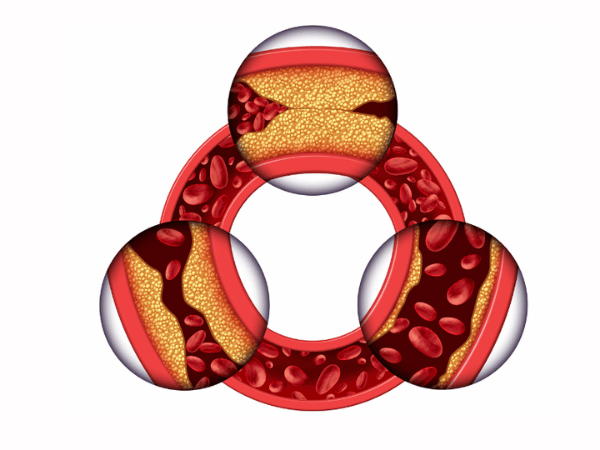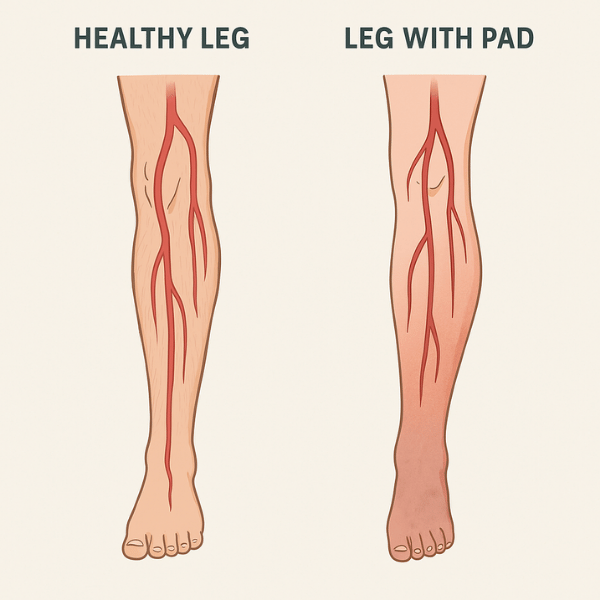Peripheral artery disease (PAD) is a progressive condition characterized by plaque buildup in the arteries, commonly referred to as atherosclerosis. As the plaque builds up, it can restrict the flow of essential blood, nutrients, and oxygen to the lower extremities, leading to chronic leg pain and numbness.
For many years, PAD has been seen as a male-dominated condition; however, studies show that women often exhibit atypical PAD symptoms, which makes it harder to diagnose.¹ There are also varying symptoms and risk factors for PAD in women vs. men.
Knowing the gender-specific PAD risk factors and symptoms will allow you to seek an early diagnosis. The quicker PAD is caught, the less likely it is for you to develop severe complications like a heart attack, stroke, or amputation.
Gender Differences In PAD
When comparing Peripheral Artery Disease (PAD) in women vs. men, you’ll notice symptoms show differently in both genders.
PAD Symptoms in Women
Studies show that women are more likely to experience atypical symptoms¹, such as leg fatigue, heaviness, or general discomfort, rather than the classic symptom of calf pain when walking. As a result, many women may already have atherosclerosis but aren’t recognizing the warning signs until their symptoms have progressed to the later stages of PAD. This delayed diagnosis can limit the number of treatments available and increase the risk of severe complications. Women are also more likely to be diagnosed at a later age, further compounding these risks.
Signs of PAD in Men
Men typically exhibit traditional symptoms and are more likely to have an early-onset PAD. Hair loss on the legs and feet is a common symptom of PAD that’s more prevalent in men. Men may also experience erectile dysfunction.
Men are statistically less likely to seek regular medical care than women. The CDC estimates that women are 33% more likely to schedule a doctor’s appointment than men. Many men will brush off traditional symptoms as typical signs of aging and avoid seeking treatment.
Annual vascular screenings, such as the ankle-brachial index (ABI) test, can detect both atypical and traditional symptoms. Early detection can help both men and women with PAD get access to minimally invasive treatment.
BOOK YOUR VASCULAR SCREENING TODAY
Are There Gender-Specific Risk Factors for PAD?
There are several gender-specific risk factors for PAD:
For women, the major PAD risk factor is hormonal changes during pregnancy, perimenopause, and menopause. Estrogen helps maintain healthy cholesterol levels and reduces vascular inflammation. A decrease in estrogen is common for women in their 40s and beyond. These hormone changes can affect the blood vessels and reduce blood circulation, thereby increasing the risk of peripheral artery disease (PAD).
Men are more likely to smoke than women, and smoking remains one of the biggest risk factors for PAD. While type 2 diabetes is a major contributor to PAD in both genders, men may develop it earlier or with fewer warning signs, adding to their risk.
Here’s a look at the different shared PAD risk factors among both genders:
- Over the age of 50
- Current or former smoker
- Diabetic
- Unmanaged blood pressure or cholesterol levels
- Family history of vascular disease
- African-American descent
- Elevated plaque levels
- Obesity
Diagnosis of PAD in Women vs. Men
Peripheral artery disease (PAD) can present differently in men and women, which may impact how and when it is diagnosed. Women are more likely to experience atypical or subtle symptoms—such as fatigue, leg discomfort, or difficulty walking—rather than the classic symptom of leg pain or cramping during activity (claudication). As a result, PAD in women may be underrecognized or diagnosed at a more advanced stage.
Men are often diagnosed earlier, potentially because they are more likely to experience typical PAD symptoms. However, studies also show that both men and women face delays in diagnosis due to limited awareness and overlapping risk factors.
Annual vascular screenings can help ensure early detection and increase access to minimally invasive treatment options for everyone, regardless of gender.
PAD Treatment Options
If PAD is caught early on, minimally invasive treatments may be available. Depending on the severity of your condition, a vascular doctor may recommend one of the following treatments:
- Angioplasty: An angioplasty may be needed if you have a moderate blockage in an affected artery. During this procedure, a small catheter with a balloon is inserted to compress the plaque against the artery walls, helping to widen the artery and restore blood flow.
- Stent placement: If the blockage is more severe or shows signs of narrowing again, a stent may be placed inside the artery. With a stent placement, a mesh tube is placed inside the artery to keep it propped open. Stents may be placed alongside an angioplasty. If an angioplasty is not necessary, carotid stenting or the use of self-expanding stents can be considered.
- Atherectomy: Compressing the plaque against the artery wall using a balloon might not be possible if it’s too hard or heavily calcified. In these cases, an atherectomy might be needed to remove the plaque from the artery. During this procedure, a specialized catheter removes the plaque using a special laser or tiny blade.
USA Vascular Centers specializes in developing personalized treatment plans for each individual. Our vascular specialists will discuss the available treatment options and determine which approach is best for your condition.
LEARN MORE ABOUT TREATMENT OPTIONS
Take Control of Your Vascular Health
Symptoms, diagnosis, and treatments for peripheral artery disease in men vs. women can vary. Whether you have been diagnosed with peripheral artery disease or are exhibiting signs of PAD, schedule a consultation with a vascular specialist for an accurate diagnosis.
USA Vascular Centers accepts most insurance plans, including Medicare and Medicaid. You can verify your insurance when you schedule your appointment online or by calling us at 888.773.2193.
FAQs
Do sex hormones influence peripheral artery disease?
Yes, changes in estrogen levels and testosterone can lead to inflammation in the vascular system, increasing your risk of developing PAD.
Why is PAD often misdiagnosed in women?
PAD is often misdiagnosed in women because they are more likely to develop atypical PAD symptoms.
Are women more likely to develop critical limb ischemia from PAD?
Women are more likely to develop critical limb ischemia (a severe form of peripheral artery disease) than men because they tend to experience asymptomatic PAD, which can lead to a more advanced disease before appropriate diagnosis and treatment.
Sources Cited
- Porras, C. (n.d.). Differences in Symptom Presentation in Women and Men with Confirmed Lower Limb Peripheral Artery Disease: A Systematic Review and Meta-Analysis. Science Direct. https://www.sciencedirect.com/science/article/pii/S1078588421010327




